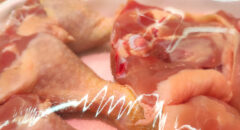
You rarely ever can have an easy time choosing an protein bar…wherever you go, there are just far too many of them, and it’s so difficult to figure out which one is the best one (and which one doesn’t taste like tree bark). Or if you should even bother eating one at all.
Celebrate great health! LIKE BlackDoctor.org on Facebook!
To make the decision a little easier, think about why you want a bar in the first place. Additional protein? A handy snack? A post-workout meal? Whatever your reasoning, remember that these bars are not a necessary part of a healthy, balanced diet.
Before you buy, remember these pros and cons:
Energy Bar Pros…
There are a lot of reasons why energy bars are so popular. In general, energy bars:
- Can help meet your energy (calorie) needs
- Can help meet your nutritional needs, especially if you need help getting calcium, zinc, vitamin D, vitamin B-12, folic acid, protein or fiber
- Are portable, convenient and pre-packaged
- Have a long shelf life and don’t require refrigeration
Energy Bar Cons…
- Excessive nutrients. Energy bars can contribute to an excessive intake of nutrients, especially if you are eating more than one bar daily, take a multivitamin supplement, and eat other fortified (enriched) foods and beverages.
- The dangers of over-supplementation vary from minor intestinal discomforts (diarrhea and constipation) to liver disease, nerve damage or even death.
- Excessive calories. Energy bars may contribute to a high caloric intake, which can lead to weight gain.
- Cost. At $1.00 to $2.00 a bar, this convenience food can quickly become a major expense on your grocery bill.
- Abdominal discomforts. Some energy bars (especially low-sugar or low-carb varieties) contain sugar alcohols, which can cause bloating, gas and diarrhea in some individuals.
- Lack of data. There is very little research to support the actual need for energy bars. They are not a magical food and should not be used as a constant replacement for whole foods in your diet.
- Processing. Energy bars are a highly processed food, whereas whole, unprocessed foods should be the staples of a healthy diet.
- Additives. Some energy bars contain additional herbal ingredients. There is no data to show that any of these herbs are effective. Herbs have no standards regarding potency or safety, and many result dangerous allergic and drug interactions.
To make sure the next bar you eat isn’t just a glorified candy bar masquerading as healthy, use the following checklist, based on your needs—meal replacement, afternoon snack, or workout fuel.
Meal Replacement Bars
When lunch is out of reach, an energy bar can be used on occasion. Adding a piece of fruit, some raw veggies, and a serving of yogurt or milk can help round out this quick, on-the-go meal.
Read the nutrition label to find a bar that contains:
- About 200-300 calories
- 2.5 to 5 grams of fiber
- Less than 20 grams of sugar
- Less than 2.5 grams saturated fat and 0 grams trans fat
- About 30% of your RDA for vitamins and minerals (optional)
- Approximately 40% carbohydrates (20-30 grams), 30% protein (15-22 grams) and 30% fat (7-10 grams or less)
Afternoon Snack Bars
For your afternoon snack, be aware that many energy bars have a calorie level similar to candy bars. If you are watching your calories or trying to lose weight, it can be difficult to find a low-calorie bar that doesn’t contain sugar alcohols (see “Cons” above).
Eating half of an energy bar or choosing another type of snack might be a better idea for waist-watchers. For individuals who aren’t looking to lose weight, energy bars are still better choices than candy bars because they contain added nutritional benefits.
Read the nutrition label to find a bar that contains:
- About 150-200 calories
- At least 1.5 grams of fiber
- Less than 15 grams of sugar
- Less than 2 grams saturated fat and 0 grams trans fat
- About 30% of your RDA for vitamins and minerals (optional)
- Approximately 40%-60% carbohydrates (15-30 grams), 20%-30% protein (7-15 grams) and 20%-30% fat (3-7 grams or less)
Workout Fuel
Before hitting the gym or starting a long run, your body needs carbohydrates. It is best to avoid protein, fat, fiber and sugar alcohols, all of which can delay the emptying time of the stomach and slow digestion, causing cramps and sluggish energy levels. Energy bars are usually too high in protein, fat, fiber, and possibly sugar alcohols to be used for pre-exercise nourishment. Instead, try another carbohydrate-rich food.
During your workout, energy bars are not an appropriate refueling choice because aerobic and high-intensity exercises require blood flow to the muscles, not to the stomach for the digestion of foods. After exercising for more than 60-90 minutes, consider a sports drink or sports gel to boost your energy levels, promote hydration, and balance electrolytes in the body.
Energy bars may work for low-intensity, very long-duration activities such as a long, slow hike or bike ride. (During lower-intensity exercise, less blood is diverted to the muscles.)
After your exercise session, your body needs mostly carbohydrates (to replenish glycogen stores in the muscles), some protein (to help repair damaged muscle tissue), and a little fat (for cellular repair). Eating a “real” and complete meal is your best bet. But if you cannot eat a meal within two hours working out, then an energy bar paired with a glass of water and a piece of fruit is a good option. Look for a meal replacement bar (see examples above) with at least 30 grams of carbohydrate, 10 grams (or more) of protein, and 5-10 gram of fat.
Bar Alternatives
Don’t ever feel that you have to rely on bars to meet your calorie and nutritional needs. These snack ideas provide energy, nutrition and flavor in a convenient, budget-friendly package:
- Fresh fruits: apples, oranges, pears, plums, grapes, bananas
- Individually packaged fruit and applesauce
- Yogurt or string cheese
- Whole grain crackers (plain or with cheese or peanut butter)
- Bagels and muffins
- Homemade trail mix
- Granola bars
- Carton of milk or juice
- Graham crackers








